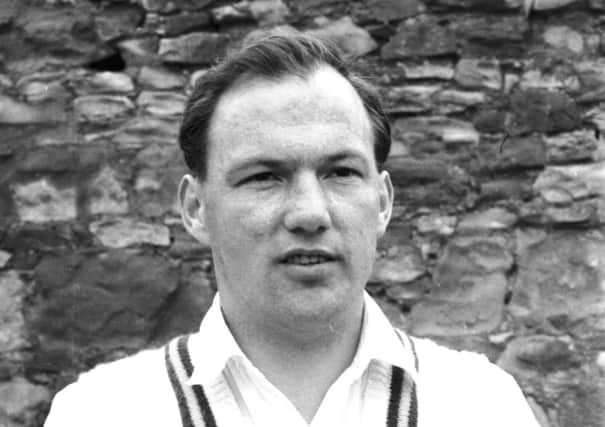Obituary: James “Jimmy” Brown MBE, cricket player


A memorial service is to be held at Kinnoull Parish Church in Perth on Saturday, 17 January in Kinnoull Parish Church, Dundee Road, Perth, to commemorate the life of Jimmy Brown, inarguably the finest wicket-keeper batsman ever to represent Scotland.
On the previous day his ashes will be interred at Perth Cemetery alongside those of his father and mother.
Advertisement
Hide AdAdvertisement
Hide AdBrown’s death from heart failure in Dublin followed not long after the passing of fellow Perthshire and Scotland cricketer Bob Young, who represented Scotland in nine “cap” matches in the early 1960s.
They were both members of a Perthshire team that dominated Scottish cricket for many years in the middle of the last century, playing alongside the likes of Leonard Dudman, the Laing brothers and Mike Kerrigan. Brown himself would go on to captain his country 53 times between 1953 and 1973. He was also one of the few Scots to play top-class football and first-class cricket.
James Brown, always known as Jimmy, was born the son of Alexander, an engineer, and Margaret, née Sutton. He was the youngest of four children, his sisters being Jenny, Helen and Margaret.
He was educated at Perth Academy where he excelled at sport, particularly cricket and football and he later enjoyed ice hockey, playing as a goal minder, as well as being a keen golfer.
It was as an inside forward on the football pitch that Brown first came to sporting prominence. He played for Luncarty Juniors and was selected to play for the Scottish Juniors against their Northern Irish equivalents in Belfast.
He joined Queen’s Park and was recognised as a promising talent before his footballing career was halted by a knee ligament injury.
His cricketing career was by then well under way. Brown joined the local Northern club before being called up to Perthshire, where he made his first XI debut at the age of just 17. He would go on to be an almost permanent fixture for the great Perthshire side of the 1950s to 1970s, amassing a total of 674 dismissals.
His progress was not halted by National Service as a wireless officer with the RAF, as he was able to play for Aberdeenshire while posted to Dyce.
Advertisement
Hide AdAdvertisement
Hide AdReturning to Perthshire, his lightning-fast reactions were soon recognised, not least his capacity for stumpings which formed a significant part of his dismissal record. For those not in the cricketing “know”, the art of stumping requires courage to stand up close to the wicket, as well as speed and skill in taking off the bails, and Brown was generally reckoned to be one of the best stumpers in Britain.
He was soon capped for Scotland and played in matches against the likes of the West Indians and Pakistan. He acquitted himself well keeping wicket against the very fastest bowlers such as Wes Hall of the West Indies and the Australian Alan Preen.
In all, he represented Scotland on no fewer than 85 occasions, then a record number. Also a record was his total of 53 appearances as captain. His 159 dismissals for Scotland – also then a record – included 40 stumpings. In what was a rare honour for a Scot, he was selected to play for the Gentlemen against the Players in a match at Scarborough in 1960.
He became almost a legendary figure at Perthshire, the North Inch side enjoying its most remarkable run almost as soon as he began playing for them. It was no coincidence that much of the heyday of Brown took place during Perthshire’s run of 20 Scottish county championships from 1953 to 1978.
As a captain, Brown was noted for his diplomatic approach off the field as well as his good tactics on the green sward. Always the most affable of men, he could be relied on to tell a good story in the clubhouse or at club dinners.
In his non-sporting life, Brown joined the Bell’s whisky firm after National Service and was a member of their formidable sales team. Later he was approached to join Peter Thomson and Sons whisky blenders and wine merchants in Perth and he progressed there to the position of marketing manager before becoming a director of the company that was probably best known for its Beneagles blend. He left the firm in 1984 when it was sold to Sir Reo Stakis, and became the licensee of the Cathkin Inn at Burrelton until 1989.
After his retirement from playing cricket, Brown had joined the administrative side of the Scottish Cricket Union, serving as a North District representative on the Committee from 1977 to 1979. His son Trevor followed in his father’s footsteps, keeping wicket for Perthshire. Trevor recalled that his father was always supportive, even though the son admits that he could never have reached the heights that his father did.
Brown was honoured with an MBE for his services to sport in 1974 and was inducted into the Scottish Cricket Hall of Fame in 2012. He received his honour at the International match between Scotland and Ireland in Dublin in 2013.
Advertisement
Hide AdAdvertisement
Hide AdBrown was married to Constance, known as Connie, for 39 years until her death from cancer in 1997. The following year he himself underwent heart bypass surgery, but apart from his heart troubles which eventually became heart failure, Brown remained fit until late age.
A chance meeting with old friends from cricketing days led to a reunion with Margaret “Peggy” Dawson who became his partner in life and he moved to Dublin to spend his final years with her. They enjoyed many a round of golf until his health deteriorated.
Jimmy Brown is survived by sons Denis, Trevor and Alan, his granddaughter Lucy, partner Peggy and sister Margaret. The family have asked that friends and relatives join them at the Memorial Service at Kinnoull.